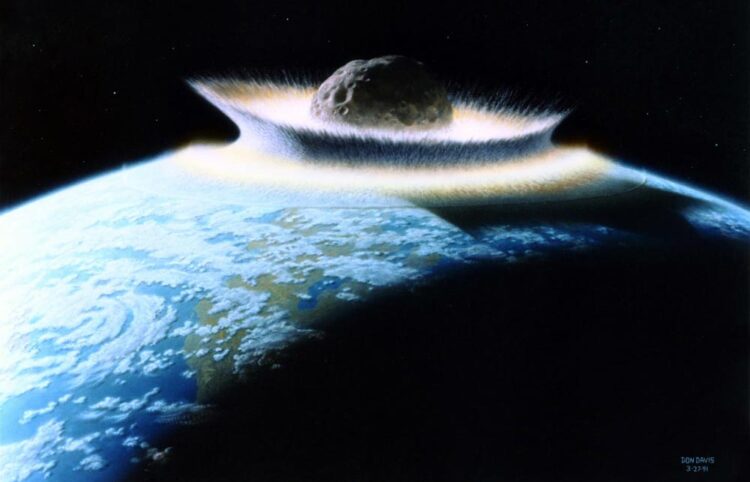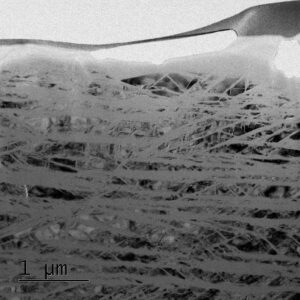Asteroid impact in slow motion

Large asteroid impacts can melt significant amounts of material from Earth's crust (artist's impression). Credit: NASA, Don Davis
High-pressure study solves 60-year-old mystery.
For the first time, researchers have recorded live and in atomic detail what happens to the material in an asteroid impact. The team of Falko Langenhorst from the University of Jena and Hanns-Peter Liermann from DESY simulated an asteroid impact with the mineral quartz in the lab and pursued it in slow motion in a diamond anvil cell, while monitoring it with DESY’s X-ray source PETRA III. The observation reveals an intermediate state in quartz that solves a decades-old mystery about the formation of characteristic lamellae in quartz hit by an asteroid. Quartz is ubiquitous on the Earth’s surface, and is, for example, the major constituent of sand. The analysis helps to better understand traces of past impacts, and may also have significance for entirely different materials. The researchers present their findings in the journal Nature Communications.
Impact indicator
Asteroid impacts are catastrophic events that create huge craters and sometimes melt parts of Earth’s bedrock.“ Nevertheless, craters are often difficult to detect on Earth, because erosion, weathering and plate tectonics cause them to disappear over millions of years,” Langenhorst explains. Therefore, minerals that undergo characteristic changes due to the force of the impact often serve as evidence of an impact. For example, quartz sand (which chemically is silicon dioxide, SiO2) is gradually transformed into glass by such an impact, with the quartz grains then being crisscrossed by microscopic lamellae. This structure can only be explored in detail under an electron microscope. It can be seen in material from the relatively recent and prominent Barringer crater in Arizona, USA, for example.“For more than 60 years, these lamellar structures have served as an indicator of an asteroid impact, but no one knew until now how this structure was formed in the first place,” Liermann says. “We have now solved this decades-old mystery.” To do so, the researchers had spent years modifying and advancing techniques that allow materials to be studied under high pressure in the lab. In these experiments, samples are usually compressed between two small diamond anvils in a so-called diamond anvil cell (DAC). It allows extreme pressures – as prevalent in Earth’s interior or in an asteroid impact – to be generated in a controlled manner.
Characteristic lamellae

For its experiments, the team used a dynamic diamond anvil cell (dDAC) in which the pressure can be changed very quickly during the measurement. With this device, the scientists compressed small quartz single crystals stronger and stronger, while shining PETRA III’s intense X-ray light through them to investigate changes to their crystal structure. “The trick is to let the simulated asteroid impact proceed slowly enough to be able to follow it with the X-ray light, but not too slowly, so that the effects typical of an asteroid impact can still occur,” Liermann says. Experiments on the scale of seconds proved to be the right duration.“We observed that at a pressure of about 180,000 atmospheres, the quartz structure suddenly transformed into a more tightly packed transition structure, which we call rosiaite-like,” reports first author Christoph Otzen, who is writing his doctoral thesis on these studies. “In this crystal structure, the quartz shrinks by a third of its volume. The characteristic lamellae form exactly where the quartz changes into this so-called metastable phase, which no one has been able to identify in quartz before us.” Rosiaite is an oxidic mineral and the namesake for the crystal structure that is known from various materials. It does not consist of silica, but is a lead antimonate (a compound of lead, antimony and oxygen).
Collapse into disorder
“The higher the pressure rises, the larger the ratio of silica with a rosiaite-like structure in the sample,” Otzen explains. “But when the pressure drops again, the rosiaite-like lamellae do not transform back into the original quartz structure, but collapse into glass lamellae with a disordered structure. We also see these lamellae in quartz grains from deposits of asteroid impacts.”Quantity and orientation of the lamellae allow conclusions to be drawn about the impact. For instance, they indicate how high the impact pressure has been. “For decades, such lamellae have been used to detect and analyze asteroid impacts,” Langenhorst points out. “But only now can we accurately explain and understand their formation.
For the study, the researchers did not use the highest pressures technically feasible. “In the range of the highest pressures, so much heat is generated that the material melts or vaporizes,” explains Langenhorst. “Molten material that solidifies back into rock doesn’t give us much useful information for now. What is important, however, is precisely the pressure range in which minerals undergo characteristic changes in the solid state, and that’s what we studied in this case.”
Model for glass formation?
The results could have significance beyond the study of asteroid impacts. “What we observed could be a model study for the formation of glass in completely different materials such as ice,” Langenhorst points out. “It might be the generic path that a crystal structure transforms into a metastable phase in an intermediate step during rapid compression, which then transforms into the disordered glass structure. We plan to investigate this further, because it could be of great importance for materials research.”
With the planned transformation of PETRA III at DESY into the world’s best X-ray microscope, PETRA IV, such studies will be even more realistically possible in the future. “A 200 times higher X-ray intensity will allow us to run these experiments 200 times faster, so we can simulate an asteroid impact even more realistically,” says Liermann.
Reference:
Evidence for a rosiaite-structured high-pressure silica phase and its relation to lamellar amorphization in quartz; Christoph Otzen, Hanns-Peter Liermann, Falko Langenhorst; Nature Communications, 2023; DOI: 10.1038/s41467-023-36320-7
https://www.desy.de/news/news_search/index_eng.html?openDirectAnchor=2556&two_columns=1
Media Contact
All latest news from the category: Physics and Astronomy
This area deals with the fundamental laws and building blocks of nature and how they interact, the properties and the behavior of matter, and research into space and time and their structures.
innovations-report provides in-depth reports and articles on subjects such as astrophysics, laser technologies, nuclear, quantum, particle and solid-state physics, nanotechnologies, planetary research and findings (Mars, Venus) and developments related to the Hubble Telescope.
Newest articles

Innovative 3D printed scaffolds offer new hope for bone healing
Researchers at the Institute for Bioengineering of Catalonia have developed novel 3D printed PLA-CaP scaffolds that promote blood vessel formation, ensuring better healing and regeneration of bone tissue. Bone is…

The surprising role of gut infection in Alzheimer’s disease
ASU- and Banner Alzheimer’s Institute-led study implicates link between a common virus and the disease, which travels from the gut to the brain and may be a target for antiviral…

Molecular gardening: New enzymes discovered for protein modification pruning
How deubiquitinases USP53 and USP54 cleave long polyubiquitin chains and how the former is linked to liver disease in children. Deubiquitinases (DUBs) are enzymes used by cells to trim protein…


